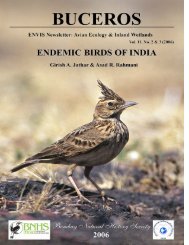Untitled - ENVIS Centre on Avian Ecology
Untitled - ENVIS Centre on Avian Ecology
Untitled - ENVIS Centre on Avian Ecology
Create successful ePaper yourself
Turn your PDF publications into a flip-book with our unique Google optimized e-Paper software.
place during the 1990s leading to a sense of unease about<br />
the status of the species in India 7,8 .<br />
Main threats: In Asia, as with many other large<br />
waterbirds, the species is primarily threatened by a<br />
combinati<strong>on</strong> of habitat loss and modificati<strong>on</strong> (owing<br />
primarily to agricultural expansi<strong>on</strong>), polluti<strong>on</strong> and<br />
persecuti<strong>on</strong>, and it has been extirpated from large<br />
proporti<strong>on</strong>s of its historical range and hugely reduced in<br />
numbers in the areas which it still occupies. During the<br />
1999 Sarus Crane census throughout India, the major<br />
threat listed by participants was the spread of agriculture<br />
to the shores of wetlands 5 . Habitat availability is also<br />
reduced by mud removal activities, vegetati<strong>on</strong> clearing,<br />
vegetati<strong>on</strong> overgrowth and reclamati<strong>on</strong> 5 .<br />
C<strong>on</strong>servati<strong>on</strong> measures: The species is listed <strong>on</strong> Appendix<br />
II of CITES. It receives full legal protecti<strong>on</strong> in all range<br />
countries (although appearing <strong>on</strong>ly <strong>on</strong> Schedule IV of the<br />
Indian Wildlife Act 1972). Of the 10 Asian countries where<br />
it is found, eight are signatories to the Ramsar C<strong>on</strong>venti<strong>on</strong><br />
(the excepti<strong>on</strong>s are Laos and Myanmar).<br />
Buceros Vol. 7, No. 1 & 2 (2002)<br />
References: 1. Roberts 1991–1992; 2. Meine and<br />
Archibald 1996; 3. Wells 1999; 4. Sundar et al. in press;<br />
5. Choudhury, B. C. et al. 1999; 6. Gole 1989; 7.<br />
Choudhury, B. C. 1998; 8. Sundar and Choudhury 1999.<br />
Sarus Crane in some of the IBAs<br />
Rajasthan: 1.Keoladeo NP, 2.Ranthambore TR, 3.<br />
Sariska NP, 4. Bund Baretha WLS; Madhya Pradesh:<br />
1. Dihaila Jheel, 2. Kanha NP, 3. Panna NP, 4. Nati<strong>on</strong>al<br />
Chambal WLS, 5. Bandhavgarh NP, S<strong>on</strong>e Gharial WLS;<br />
Gujarat: 1. Gir NP, 2. Khijadiya WLS, 3. Lala Great<br />
Indian Bustard WLS, 4. Marine NP, 5.Nalsarovar WLS,<br />
6. Thol Lake WLS, 7. Velavadar NP, 8. Rudra Mata Dam;<br />
Uttar Pradesh: 1.Hastinapur WLS, 2. Kishanpur WLS,<br />
3. Lakhbahosi Bird Sanctuary, 4. Patna Bird Sanctuary,<br />
5. Nawabganj Bird Sanctuary, 6. Samastipur Bird<br />
Sanctuary, 7. Sheikha Jheel, 8. Tikra Jheel; Haryana:<br />
1.Bhindawas WLS, 2. Sultanpur WLS; Maharashtra:<br />
1. Tadoba NP, 2. Nawega<strong>on</strong> NP; Manipur: 1.Loktak<br />
Lake & Keibul-Lamjao Nati<strong>on</strong>al Park; Assam: 1. Dibru-<br />
Saikhowa NP+ Kobo Chapori+Amarpur Chapori-<br />
Maguri-Motapung Beels; Delhi: Okhla Barrage.<br />
BLACK-NECKED CRANE Grus nigricollis Vulnerable C1<br />
This species has a small, declining populati<strong>on</strong> as a result of loss and degradati<strong>on</strong> of<br />
wetlands, changing agricultural practices and increased human activity in its breeding<br />
and wintering grounds. These factors qualify it as Vulnerable.<br />
Distributi<strong>on</strong>: The breeding range of the Black-necked<br />
Crane includes much of the Qinghai–Tibetan Plateau in<br />
south-central China, with small breeding populati<strong>on</strong>s in<br />
Ladakh, and Bhutan. Very small numbers have wintered<br />
in Arunachal Pradesh.<br />
Populati<strong>on</strong>: The global populati<strong>on</strong> is estimated to be<br />
5,600–6,000 birds 1,2 , including wintering populati<strong>on</strong>s of<br />
360 in Bhutan, no more than 10 in Arunachal Pradesh,<br />
small numbers breed in Ladakh 3 , and breeding could<br />
occur in Sikkim 4 . Very small numbers of wintering birds<br />
(perhaps <strong>on</strong>ly occasi<strong>on</strong>al visitors) have also been reported<br />
from Myanmar and Vietnam. More comprehensive and<br />
coordinated counts in Ladakh in the 1980s and 1990s<br />
have located larger numbers, with a maximum populati<strong>on</strong><br />
estimate of 38 individuals in 1997, including 12 breeding<br />
pairs 3 . It is believed that a recent increase might have<br />
occurred after poaching by military pers<strong>on</strong>nel was<br />
c<strong>on</strong>trolled in the mid-1980s 3 .<br />
n n n<br />
Main threats: Intensive grazing and pesticide use has<br />
caused degradati<strong>on</strong> of grasslands in the breeding<br />
grounds. A dam planned <strong>on</strong> the Lhasa river threatens<br />
wintering birds. Fish-farming, peat and firewood<br />
collecti<strong>on</strong> and c<strong>on</strong>structi<strong>on</strong> of roads have resulted in<br />
increased disturbance and habitat degradati<strong>on</strong>. The<br />
collecti<strong>on</strong> of eggs and poaching are problems in parts<br />
of China and India. In the breeding areas of Ladakh,<br />
the high-altitude vegetati<strong>on</strong> is slow-growing and<br />
sensitive to disturbance, and direct and indirect human<br />
interference is having an increasingly detrimental<br />
impact 3 . The c<strong>on</strong>stant diminuti<strong>on</strong> of undisturbed<br />
foraging and breeding areas is exerting such pressure<br />
<strong>on</strong> the small Indian populati<strong>on</strong> that it is unlikely to<br />
survive without assistance in the form of legal and habitat<br />
protecti<strong>on</strong> 3 .<br />
C<strong>on</strong>servati<strong>on</strong> measures: CITES Appendix I and II.<br />
CMS Appendix I and II. Research c<strong>on</strong>ducted in China,<br />
43 THREATENED BIRDS OF INDIA<br />
VULNERABLE




